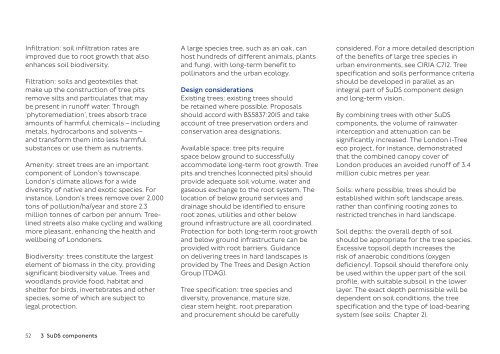SuDS in London - a guide
sustainable-urban-drainage-november-2016
sustainable-urban-drainage-november-2016
You also want an ePaper? Increase the reach of your titles
YUMPU automatically turns print PDFs into web optimized ePapers that Google loves.
Infiltration: soil <strong>in</strong>filtration rates are<br />
improved due to root growth that also<br />
enhances soil biodiversity.<br />
Filtration: soils and geotextiles that<br />
make up the construction of tree pits<br />
remove silts and particulates that may<br />
be present <strong>in</strong> runoff water. Through<br />
‘phytoremediation’, trees absorb trace<br />
amounts of harmful chemicals – <strong>in</strong>clud<strong>in</strong>g<br />
metals, hydrocarbons and solvents –<br />
and transform them <strong>in</strong>to less harmful<br />
substances or use them as nutrients.<br />
Amenity: street trees are an important<br />
component of <strong>London</strong>’s townscape.<br />
<strong>London</strong>’s climate allows for a wide<br />
diversity of native and exotic species. For<br />
<strong>in</strong>stance, <strong>London</strong>’s trees remove over 2,000<br />
tons of pollution/ha/year and store 2.3<br />
million tonnes of carbon per annum. Treel<strong>in</strong>ed<br />
streets also make cycl<strong>in</strong>g and walk<strong>in</strong>g<br />
more pleasant, enhanc<strong>in</strong>g the health and<br />
wellbe<strong>in</strong>g of <strong>London</strong>ers.<br />
Biodiversity: trees constitute the largest<br />
element of biomass <strong>in</strong> the city, provid<strong>in</strong>g<br />
significant biodiversity value. Trees and<br />
woodlands provide food, habitat and<br />
shelter for birds, <strong>in</strong>vertebrates and other<br />
species, some of which are subject to<br />
legal protection.<br />
A large species tree, such as an oak, can<br />
host hundreds of different animals, plants<br />
and fungi, with long-term benefit to<br />
poll<strong>in</strong>ators and the urban ecology.<br />
Design considerations<br />
Exist<strong>in</strong>g trees: exist<strong>in</strong>g trees should<br />
be reta<strong>in</strong>ed where possible. Proposals<br />
should accord with BS5837:2015 and take<br />
account of tree preservation orders and<br />
conservation area designations.<br />
Available space: tree pits require<br />
space below ground to successfully<br />
accommodate long-term root growth. Tree<br />
pits and trenches (connected pits) should<br />
provide adequate soil volume, water and<br />
gaseous exchange to the root system. The<br />
location of below ground services and<br />
dra<strong>in</strong>age should be identified to ensure<br />
root zones, utilities and other below<br />
ground <strong>in</strong>frastructure are all coord<strong>in</strong>ated.<br />
Protection for both long-term root growth<br />
and below ground <strong>in</strong>frastructure can be<br />
provided with root barriers. Guidance<br />
on deliver<strong>in</strong>g trees <strong>in</strong> hard landscapes is<br />
provided by The Trees and Design Action<br />
Group (TDAG).<br />
Tree specification: tree species and<br />
diversity, provenance, mature size,<br />
clear stem height, root preparation<br />
and procurement should be carefully<br />
considered. For a more detailed description<br />
of the benefits of large tree species <strong>in</strong><br />
urban environments, see CIRIA C712. Tree<br />
specification and soils performance criteria<br />
should be developed <strong>in</strong> parallel as an<br />
<strong>in</strong>tegral part of <strong>SuDS</strong> component design<br />
and long-term vision.<br />
By comb<strong>in</strong><strong>in</strong>g trees with other <strong>SuDS</strong><br />
components, the volume of ra<strong>in</strong>water<br />
<strong>in</strong>terception and attenuation can be<br />
significantly <strong>in</strong>creased. The <strong>London</strong> i-Tree<br />
eco project, for <strong>in</strong>stance, demonstrated<br />
that the comb<strong>in</strong>ed canopy cover of<br />
<strong>London</strong> produces an avoided runoff of 3.4<br />
million cubic metres per year.<br />
Soils: where possible, trees should be<br />
established with<strong>in</strong> soft landscape areas,<br />
rather than conf<strong>in</strong><strong>in</strong>g root<strong>in</strong>g zones to<br />
restricted trenches <strong>in</strong> hard landscape.<br />
Soil depths: the overall depth of soil<br />
should be appropriate for the tree species.<br />
Excessive topsoil depth <strong>in</strong>creases the<br />
risk of anaerobic conditions (oxygen<br />
deficiency). Topsoil should therefore only<br />
be used with<strong>in</strong> the upper part of the soil<br />
profile, with suitable subsoil <strong>in</strong> the lower<br />
layer. The exact depth permissible will be<br />
dependent on soil conditions, the tree<br />
specification and the type of load-bear<strong>in</strong>g<br />
system (see soils: Chapter 2).<br />
52 3 <strong>SuDS</strong> components


